Global Physician Dispensed Skincare Market, By Product Type, By Formulation Type, By End User, By Distribution Channel, By Region & Segmental Insights Trends and Forecast, 2024 – 2034
- Industry: Healthcare
- Report ID: TNR-110-1111
- Number of Pages: 420
- Table/Charts : Yes
- May, 2024
- Base Year : 2024
- No. of Companies : 10+
- No. of Countries : 29
- Views : 10169
- Covid Impact Covered: Yes
- War Impact Covered: Yes
- Formats : PDF, Excel, PPT
In Terms of Revenue, the Global Physician Dispensed Skincare Market was Worth US$ 1.9 Bn in 2023 and is Anticipated to Witness a CAGR of 7.4% During 2024 – 2034.
Physician dispensed skincare refers to skincare products that are recommended and sold exclusively through medical professionals, such as dermatologists and plastic surgeons. These products often contain higher concentrations of active ingredients compared to over-the-counter options and are tailored to address specific skin concerns, including acne, aging, and hyperpigmentation. The growth drivers of the physician dispensed skincare market include increasing consumer awareness about the benefits of professional-grade skincare, a rising prevalence of skin conditions, and advancements in skincare technology. The growing trend towards personalized skincare solutions and the influence of social media and online platforms in promoting dermatological expertise contribute to market expansion. The aging global population also fuels demand for anti-aging treatments, further boosting market growth.
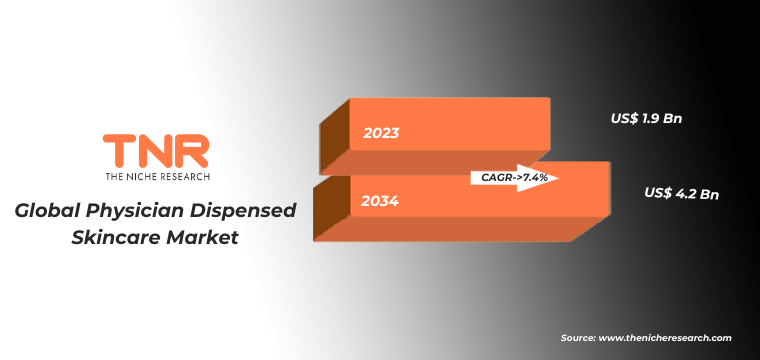
Physician Dispensed Skincare Market Dynamic
Growth Driver-
Increasing Consumer Awareness and Demand for Professional-Grade Skincare Solutions
As consumers become more knowledgeable about skin health and the efficacy of medical-grade products, they are more inclined to seek advice from healthcare professionals. These products often contain higher concentrations of active ingredients and are backed by clinical research, offering more effective results for various skin concerns such as acne, aging, and hyperpigmentation. The rise of social media and beauty influencers has amplified the visibility of these products, encouraging consumers to pursue high-quality skincare solutions recommended by experts. This growing awareness and demand are crucial in driving the expansion of the physician dispensed skincare market.
Trends-
Increasing Demand for Personalized Skincare Solutions
Consumers are moving away from one-size-fits-all products and seeking customized regimens tailored to their unique skin types and concerns. This trend is driven by advancements in skincare technology, such as genetic testing and AI-driven skin analysis, which enable precise identification of individual skin needs. Medical professionals can now offer bespoke treatment plans that incorporate these insights, enhancing the effectiveness of skincare routines. The personalization trend is further amplified by the influence of social media and digital platforms, where consumers share their experiences and results, fostering a community that values tailored, science-backed skincare solutions.
Challenge-
High Cost of Products
These professional-grade skincare solutions often come with a premium price tag due to their advanced formulations and higher concentrations of active ingredients. This can make them inaccessible to a broader audience, limiting market growth. The need for a medical consultation to access these products can add to the overall expense and inconvenience for consumers. Economic factors, such as inflation and reduced discretionary spending, can further impact consumer willingness to invest in these high-cost skincare options. Overcoming this challenge requires strategies to demonstrate value and efficacy to consumers, as well as potentially developing more affordable product lines without compromising quality.
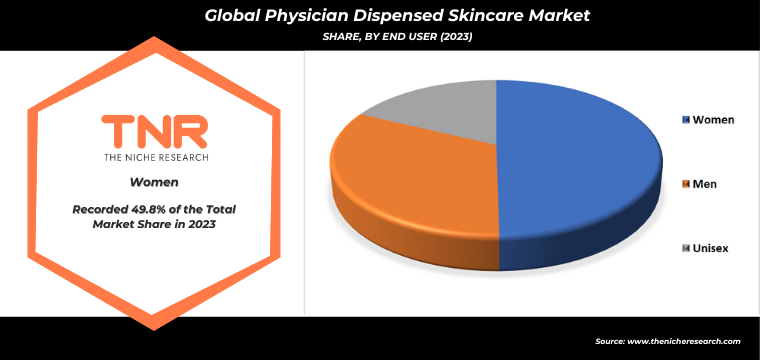
Physician Dispensed Skincare Market Segmentation by Product Type, Formulation Type, End User, Distribution Channel and Region
Skin lightening and brightening products segment is set to dominate the physician dispensed skincare market, capturing a substantial 22.7% revenue share over the forecast period. This dominance is driven by increasing consumer demand for solutions that address hyperpigmentation, uneven skin tone, and dark spots, conditions often exacerbated by environmental factors and aging. Advanced formulations with potent ingredients such as hydroquinone, vitamin C, and retinoids, available through medical professionals, offer effective results, bolstering this segment’s appeal. The rising popularity of flawless, radiant skin promoted by beauty influencers and social media trends fuels market growth. As consumers seek professional advice for achieving brighter skin, the demand for these specialized products continues to surge.
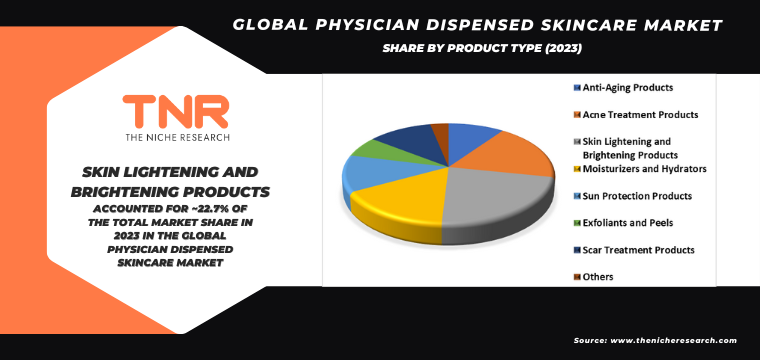
Gels are projected to experience the fastest growth in the physician dispensed skincare market, securing a significant revenue share of 24.8% over the forecast period. Gels are favored for their lightweight, non-greasy texture, making them suitable for various skin types, particularly oily and acne-prone skin. They provide quick absorption and effective delivery of active ingredients, enhancing their appeal. Gels often incorporate advanced formulations that offer targeted treatment for specific skin concerns, such as acne, rosacea, and anti-aging. Their versatility in addressing diverse dermatological needs and the rising consumer preference for efficient, easy-to-apply products contribute significantly to the robust expansion of the gel segment in the market.

Offline segment is set to dominate the physician dispensed skincare market, capturing a substantial 64.7% revenue share over the forecast period. This dominance is primarily due to the trust and personalized service that in-person consultations with healthcare professionals provide. Patients prefer the reassurance of face-to-face interactions, where dermatologists can conduct thorough skin assessments and recommend tailored skincare solutions. Moreover, the tactile experience of trying products in a clinical setting enhances consumer confidence in their efficacy. The offline segment also benefits from the established reputation and credibility of medical facilities, which are crucial in a market where product effectiveness and safety are paramount. Also, the ability to build long-term patient-doctor relationships fosters loyalty and repeat purchases, further driving revenue.
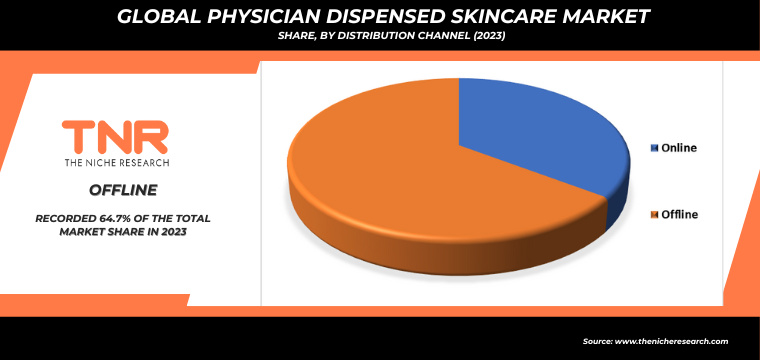
In 2023, North America is anticipated to play a significant role in propelling the growth of the physician dispensed skincare market, contributing approximately 34.1% to its overall expansion.
This significant contribution is driven by several factors, including the high prevalence of skin conditions such as acne, eczema, and hyperpigmentation in the region. The advanced healthcare infrastructure and widespread access to dermatological services facilitate the adoption of medical-grade skincare products. North American consumers are increasingly aware of the benefits of professional skincare solutions, supported by strong marketing efforts and the influence of social media. Moreover, the region’s high disposable income levels allow for greater investment in premium skincare products, further propelling market growth. This combination of factors positions North America as a pivotal player in the market’s expansion.
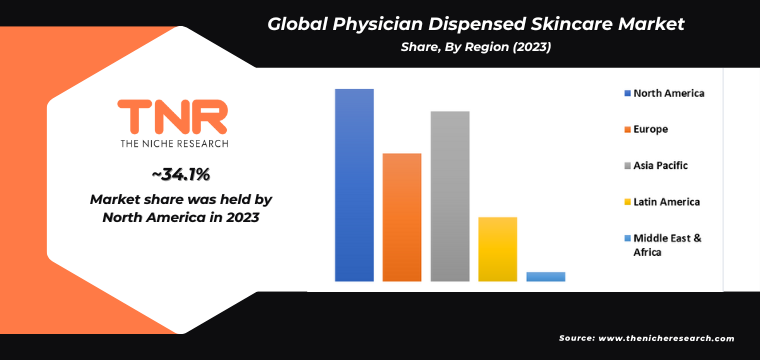
Key Developments
- In 2019, Galderma, a prominent company in the physician-dispensed cosmeceuticals market, formed a partnership with Colorescience, a cosmetics firm known for its mineral-based sunscreens and other skincare products. This collaboration aimed to broaden the variety of skincare solutions available to both patients and consumers.
- In June 2019, AbbVie, a U.S.-based pharmaceutical company, revealed its agreement to acquire Allergan for $63 billion. This move will bring Allergan back under U.S. jurisdiction for tax purposes.
Major Players in Physician Dispensed Skincare Market
- AbbVie Inc.
- Biopelle, Inc.
- Clinique Laboratories, LLC
- Cutera, Inc.
- GALDERMA
- JMSR, Inc.
- La Roche-Posay
- Neutrogena Corp.
- Obagi Medical Products, Inc.
- Procter & Gamble
- SkinCeuticals
- SkinMedica, Inc.
- Stiefel Laboratories, Inc.
- Other Industry Participants
Global Physician Dispensed Skincare Market Scope
| Report Specifications | Details |
| Market Revenue in 2023 | US$ 1.9 Bn |
| Market Size Forecast by 2034 | US$ 4.2 Bn |
| Growth Rate (CAGR) | 7.4% |
| Historic Data | 2016 – 2022 |
| Base Year for Estimation | 2023 |
| Forecast Period | 2024 – 2034 |
| Report Inclusions | Market Size & Estimates, Market Dynamics, Competitive Scenario, Trends, Growth Factors, Market Determinants, Key Investment Segmentation, Product/Service/Solutions Benchmarking |
| Segments Covered | By Product Type, By Formulation Type, By End User, By Distribution Channel, By Region |
| Regions Covered | North America, Europe, Asia Pacific, Middle East & Africa, Latin America |
| Countries Covered | U.S., Canada, Mexico, Rest of North America, France, The UK, Spain, Germany, Italy, Nordic Countries (Denmark, Finland, Iceland, Sweden, Norway), Benelux Union (Belgium, The Netherlands, Luxembourg), Rest of Europe, China, Japan, India, New Zealand, Australia, South Korea, Southeast Asia (Indonesia, Thailand, Malaysia, Singapore, Rest of Southeast Asia), Rest of Asia Pacific, Saudi Arabia, UAE, Egypt, Kuwait, South Africa, Rest of Middle East & Africa, Brazil, Argentina, Rest of Latin America |
| Key Players | AbbVie Inc., Biopelle, Inc., Clinique Laboratories, LLC, Cutera, Inc., GALDERMA, JMSR, Inc., La Roche-Posay, Neutrogena Corp., Obagi Medical Products, Inc., Procter & Gamble, SkinCeuticals, SkinMedica, Inc., Stiefel Laboratories, Inc. |
| Customization Scope | Customization allows for the inclusion/modification of content pertaining to geographical regions, countries, and specific market segments. |
| Pricing & Procurement Options | Explore purchase options tailored to your specific research requirements |
| Contact Details | Consult With Our Expert
Japan (Toll-Free): +81 663-386-8111 South Korea (Toll-Free): +82-808- 703-126 Saudi Arabia (Toll-Free): +966 800-850-1643 United Kingdom: +44 753-710-5080 United States: +1 302-232-5106 E-mail: askanexpert@thenicheresearch.com
|
Global Physician Dispensed Skincare Market
By Product Type
- Anti-Aging Products
- Acne Treatment Products
- Skin Lightening and Brightening Products
- Moisturizers and Hydrators
- Sun Protection Products
- Exfoliants and Peels
- Scar Treatment Products
- Others
By Formulation Type
- Gels
- Creams and Lotions
- Toners
- Mask and Peels
- Serums
- Others
By End User
- Women
- Men
- Unisex
By Distribution Channel
- Online
- Offline
- Hospital Pharmacy
- Retail Pharmacy
- Medical Spas
- Others
By Region
- North America (U.S., Canada, Mexico, Rest of North America)
- Europe (France, The UK, Spain, Germany, Italy, Nordic Countries (Denmark, Finland, Iceland, Sweden, Norway), Benelux Union (Belgium, The Netherlands, Luxembourg), Rest of Europe)
- Asia Pacific (China, Japan, India, New Zealand, Australia, South Korea, Southeast Asia (Indonesia, Thailand, Malaysia, Singapore, Rest of Southeast Asia), Rest of Asia Pacific)
- Middle East & Africa (Saudi Arabia, UAE, Egypt, Kuwait, South Africa, Rest of Middle East & Africa)
- Latin America (Brazil, Argentina, Rest of Latin America)
Report Layout
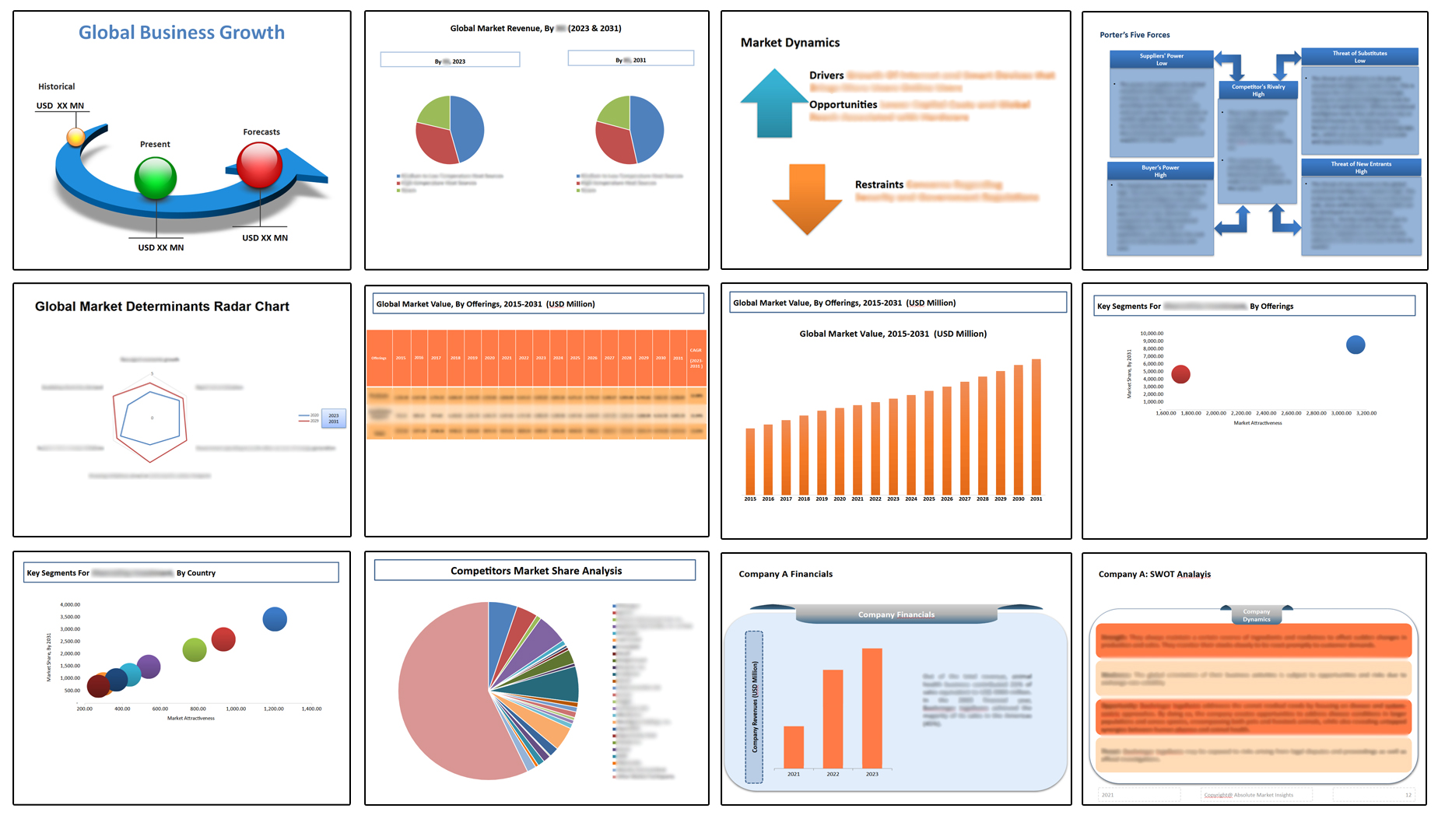
Table of Contents
Note: This ToC is tentative and can be changed according to the research study conducted during the course of report completion.
**Exclusive for Multi-User and Enterprise User.
Global Physician Dispensed Skincare Market
By Product Type
- Anti-Aging Products
- Acne Treatment Products
- Skin Lightening and Brightening Products
- Moisturizers and Hydrators
- Sun Protection Products
- Exfoliants and Peels
- Scar Treatment Products
- Others
By Formulation Type
- Gels
- Creams and Lotions
- Toners
- Mask and Peels
- Serums
- Others
By End User
- Women
- Men
- Unisex
By Distribution Channel
- Online
- Offline
- Hospital Pharmacy
- Retail Pharmacy
- Medical Spas
- Others
By Region
- North America (U.S., Canada, Mexico, Rest of North America)
- Europe (France, The UK, Spain, Germany, Italy, Nordic Countries (Denmark, Finland, Iceland, Sweden, Norway), Benelux Union (Belgium, The Netherlands, Luxembourg), Rest of Europe)
- Asia Pacific (China, Japan, India, New Zealand, Australia, South Korea, Southeast Asia (Indonesia, Thailand, Malaysia, Singapore, Rest of Southeast Asia), Rest of Asia Pacific)
- Middle East & Africa (Saudi Arabia, UAE, Egypt, Kuwait, South Africa, Rest of Middle East & Africa)
- Latin America (Brazil, Argentina, Rest of Latin America)
The Niche Research approach encompasses both primary and secondary research methods to provide comprehensive insights. While primary research is the cornerstone of our studies, we also incorporate secondary research sources such as company annual reports, premium industry databases, press releases, industry journals, and white papers.
Within our primary research, we actively engage with various industry stakeholders, conducting paid interviews and surveys. Our meticulous analysis extends to every market participant in major countries, allowing us to thoroughly examine their portfolios, calculate market shares, and segment revenues.
Our data collection primarily focuses on individual countries within our research scope, enabling us to estimate regional market sizes. Typically, we employ a bottom-up approach, meticulously tracking trends in different countries. We analyze growth drivers, constraints, technological innovations, and opportunities for each country, ultimately arriving at regional figures.Our process begins by examining the growth prospects of each country. Building upon these insights, we project growth and trends for the entire region. Finally, we utilize our proprietary model to refine estimations and forecasts.
Our data validation standards are integral to ensuring the reliability and accuracy of our research findings. Here’s a breakdown of our data validation processes and the stakeholders we engage with during our primary research:
- Supply Side Analysis: We initiate a supply side analysis by directly contacting market participants, through telephonic interviews and questionnaires containing both open-ended and close-ended questions. We gather information on their portfolios, segment revenues, developments, and growth strategies.
- Demand Side Analysis: To gain insights into adoption trends and consumer preferences, we reach out to target customers and users (non-vendors). This information forms a vital part of the qualitative analysis section of our reports, covering market dynamics, adoption trends, consumer behavior, spending patterns, and other related aspects.
- Consultant Insights: We tap into the expertise of our partner consultants from around the world to obtain their unique viewpoints and perspectives. Their insights contribute to a well-rounded understanding of the markets under investigation.
- In-House Validation: To ensure data accuracy and reliability, we conduct cross-validation of data points and information through our in-house team of consultants and utilize advanced data modeling tools for thorough verification.
The forecasts we provide are based on a comprehensive assessment of various factors, including:
- Market Trends and Past Performance (Last Five Years): We accurately analyze market trends and performance data from preceding five years to identify historical patterns and understand the market’s evolution.
- Historical Performance and Growth of Market Participants: We assess the historical performance and growth trajectories of key market participants. This analysis provides insights into the competitive landscape and individual company strategies.
- Market Determinants Impact Analysis (Next Eight Years): We conduct a rigorous analysis of the factors that are projected to influence the market over the next eight years. This includes assessing both internal and external determinants that can shape market dynamics.
- Drivers and Challenges for the Forecast Period:Identify the factors expected to drive market growth during the forecast period, as well as the challenges that the industry may face. This analysis aids in deriving an accurate growth rate projection.
- New Acquisitions, Collaborations, or Partnerships: We keep a close watch on any new acquisitions, collaborations, or partnerships within the industry. These developments can have a significant impact on market dynamics and competitiveness.
- Macro and Micro Factors Analysis:A thorough examination of both macro-level factors (e.g., economic trends, regulatory changes) and micro-level factors (e.g., technological advancements, consumer preferences) that may influence the market during the forecast period.
- End-User Sentiment Analysis: To understand the market from the end-user perspective, we conduct sentiment analysis. This involves assessing the sentiment, preferences, and feedback of the end-users, which can provide valuable insights into market trends.
- Perspective of Primary Participants: Insights gathered directly from primary research participants play a crucial role in shaping our forecasts. Their perspectives and experiences provide valuable qualitative data.
- Year-on-Year Growth Trend: We utilize a year-on-year growth trend based on historical market growth and expected future trends. This helps in formulating our growth projections, aligning them with the market’s historical performance.
Research process adopted by TNR involves multiple stages, including data collection, validation, quality checks, and presentation. It’s crucial that the data and information we provide add value to your existing market understanding and expertise. We have also established partnerships with business consulting, research, and survey organizations across regions and globally to collaborate on regional analysis and data validation, ensuring the highest level of accuracy and reliability in our reports.









